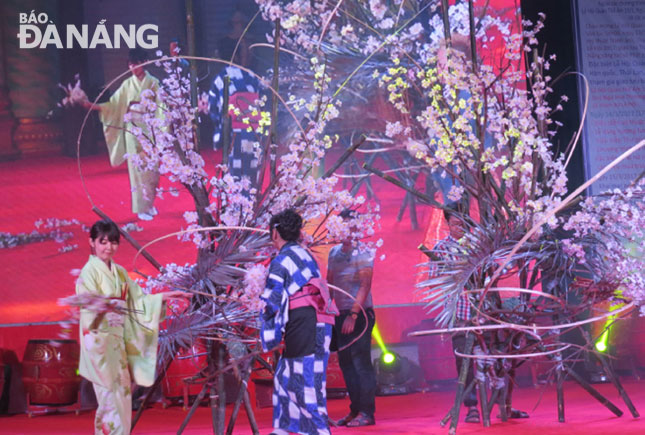Viet Nam-Japan friendship bridge signifies strong bilateral relations
Since its inception in 2014, the annual Viet Nam-Japan Cultural Exchange Festival has become an ideal space of bilateral cultural exchanges, hereby fostering the multi-faceted cooperation between Da Nang and Japanese localities, and Viet Nam and Japan as the whole.
 |
| A performance of the Japanese arts of Ikebana flower arranging at the annual Quan The Am (Avalokitesvara) Festival |
Notably, the 2017 Viet Nam-Japan Cultural Exchange Festival vividly reflected the love story involving princess Ngoc Hoa and Sotaro Araki, a Japanese navigator and merchant, who came to do business in Hoi An, a popular international commercial port over 400 years ago.
While his stay in Hoi An in 1619, Sotaro Araki fell in love and got married to princess Ngoc Hoa, the adopted daughter of King Nguyen Phuc Nguyen. According to many historical documents, Ngoc Hoa was the first Vietnamese woman to introduce the Vietnamese culture to Japan.
The love story reflected the close relationship between Japanese traders and Hoi An residents during a wealthy period of the town’s history in the early 17th centure, and helped to build a flourishing relationship between Viet Nam and Japan as a whole.
Over recent years, the Viet Nam-Japan Cultural Exchange Festival has attracted great deal of attention from Japanese nationals who are living and working in the city, along with domestic and foreign visitors, plus local residents, especially students from local junior colleges and universities.
In the spotlight at this annual festival is the introduction of the cultures and cuisines of the 2 countries through a wide range of activities including musical performances, martial arts displays, calligraphy, and fashion shows of Japanese and Vietnamese traditional costumes.
Joining in the festival, visitors can learn about the distinctive Japanese culture through its tea ceremonies, cosplay costume wearing, the traditional arts of origami (folding paper to make models), kirigami (cutting paper), and manga comic books. In particular, arts troupes from some Japanese localities are usually invited to deliver spectacular performances at the upcoming festival.
In the culinary area, visitors have the opportunity to enjoy a wide range of delicious Japanese specialities, including ‘udon’ (Japanese noodle soup), ‘ramen’ (ramen noodles), ‘kasutera’ (old-fashioned Japanese sponge cake), fresh fish and wagyu beef.
Also at the event, traditional Vietnamese arts forms are introduced to the visitors, including Apsara dance and traditional dance of Co Tu ethnic minority people.
Apart from the Viet Nam-Japan Cultural Exchange Festival, other interesting events advertising the Japanese culture have also drawn a great deal of public attention.
Notable amongst them is the annual colourful Japanese Cherry Blossom Festival (Hanami Festival), which has attracted a large number of local residents and visitors, especially young people.
In 2016, the festival took place in Asia Park, and many young people were very eager to try on a kimono, the Japanese traditional costume, and to pose for souvenir photos with the beautiful pink and white cherry blossom.
In addition, there have been a large number of exchange programmes between the youths of the 2 countries, especially trips to the cities of Mitsuke, Omachi and Matsumoto, and the Nagano and Niigata prefectures to gain an insight into their distinctive cultural values.
It is hoped that more cultural exchange events would be organised in the future in a bid to strengthen the time-honoured friendship and cooperation relationships between Viet Nam and Japan, as well as to enhance bilateral investment and tourism promotion activities.